Campanhã railway station
The Campanhã Railway Station (Portuguese: Estação Ferroviária de Campanhã) is a 19th-century railway station in the civil parish of Campanhã, in the municipality of Porto, district of Porto. Opened in 1877,[1] it is connected to the Porto Metro, with local intercity and commuter service (operated by Comboios de Portugal, the Portuguese national railway operator). The railway station provides Lisbon to north access, a through-station, and not a terminus station, serving the Lisbon-to-north allowing through running of trains from Lisbon to the north of Portugal.
Campanhã Railway Station Estação Ferroviária de Campanhã | |
|---|---|
| Railway Station | |
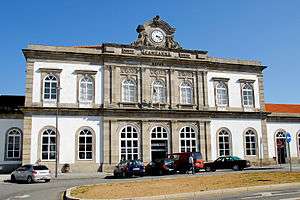 The 18th century facade of the railway station in Campanhã | |
| Location | Campanhã, Porto, Portugal |
| Coordinates | 41°08′56″N 8°35′07″W |
Porto Commuter rail | |||||||||||||||||||||||||||||||||||||||||||||||||||||||||||||||||||||||||||||||||||||||||||||||||||||||||||||||||||||||||||||||||||||||||||||||||||||||||||||||||||||||||||||||||||||||||||||||||||||||||||||||||||||||||||||||||||||||||||||||||||||||||||||||||||||||||||||||||||||||||||||||||||||||||||||||||||||||||||||||||||||||||||||||||
|---|---|---|---|---|---|---|---|---|---|---|---|---|---|---|---|---|---|---|---|---|---|---|---|---|---|---|---|---|---|---|---|---|---|---|---|---|---|---|---|---|---|---|---|---|---|---|---|---|---|---|---|---|---|---|---|---|---|---|---|---|---|---|---|---|---|---|---|---|---|---|---|---|---|---|---|---|---|---|---|---|---|---|---|---|---|---|---|---|---|---|---|---|---|---|---|---|---|---|---|---|---|---|---|---|---|---|---|---|---|---|---|---|---|---|---|---|---|---|---|---|---|---|---|---|---|---|---|---|---|---|---|---|---|---|---|---|---|---|---|---|---|---|---|---|---|---|---|---|---|---|---|---|---|---|---|---|---|---|---|---|---|---|---|---|---|---|---|---|---|---|---|---|---|---|---|---|---|---|---|---|---|---|---|---|---|---|---|---|---|---|---|---|---|---|---|---|---|---|---|---|---|---|---|---|---|---|---|---|---|---|---|---|---|---|---|---|---|---|---|---|---|---|---|---|---|---|---|---|---|---|---|---|---|---|---|---|---|---|---|---|---|---|---|---|---|---|---|---|---|---|---|---|---|---|---|---|---|---|---|---|---|---|---|---|---|---|---|---|---|---|---|---|---|---|---|---|---|---|---|---|---|---|---|---|---|---|---|---|---|---|---|---|---|---|---|---|---|---|---|---|---|---|---|---|---|---|---|---|---|---|---|---|---|---|---|---|---|---|---|---|---|---|---|---|---|---|---|---|---|---|---|---|---|---|---|---|---|
Porto metropolitan area commuter rail services | |||||||||||||||||||||||||||||||||||||||||||||||||||||||||||||||||||||||||||||||||||||||||||||||||||||||||||||||||||||||||||||||||||||||||||||||||||||||||||||||||||||||||||||||||||||||||||||||||||||||||||||||||||||||||||||||||||||||||||||||||||||||||||||||||||||||||||||||||||||||||||||||||||||||||||||||||||||||||||||||||||||||||||||||||
| |||||||||||||||||||||||||||||||||||||||||||||||||||||||||||||||||||||||||||||||||||||||||||||||||||||||||||||||||||||||||||||||||||||||||||||||||||||||||||||||||||||||||||||||||||||||||||||||||||||||||||||||||||||||||||||||||||||||||||||||||||||||||||||||||||||||||||||||||||||||||||||||||||||||||||||||||||||||||||||||||||||||||||||||||
Legend | |||||||||||||||||||||||||||||||||||||||||||||||||||||||||||||||||||||||||||||||||||||||||||||||||||||||||||||||||||||||||||||||||||||||||||||||||||||||||||||||||||||||||||||||||||||||||||||||||||||||||||||||||||||||||||||||||||||||||||||||||||||||||||||||||||||||||||||||||||||||||||||||||||||||||||||||||||||||||||||||||||||||||||||||||
| |||||||||||||||||||||||||||||||||||||||||||||||||||||||||||||||||||||||||||||||||||||||||||||||||||||||||||||||||||||||||||||||||||||||||||||||||||||||||||||||||||||||||||||||||||||||||||||||||||||||||||||||||||||||||||||||||||||||||||||||||||||||||||||||||||||||||||||||||||||||||||||||||||||||||||||||||||||||||||||||||||||||||||||||||
| Source: Official site, January 2019 | |||||||||||||||||||||||||||||||||||||||||||||||||||||||||||||||||||||||||||||||||||||||||||||||||||||||||||||||||||||||||||||||||||||||||||||||||||||||||||||||||||||||||||||||||||||||||||||||||||||||||||||||||||||||||||||||||||||||||||||||||||||||||||||||||||||||||||||||||||||||||||||||||||||||||||||||||||||||||||||||||||||||||||||||||
| Porto Metro | ||||||||||||||||||||||||||||||||||||||||||||||||||||||||||||||||||||||||||||||||||||||||||||||||||||||||||||||||||||||||||||||||||||||||||||||||||||||||||||||||||||||||||||||||||||||||||||||||||||||||||||||||||||||||||||||||||||||||||||||||||||||||||||||||||||||||||||||||||||||||||||||||||||||||||||||||||||||||||||||||||||||||||||||||||||||||||||||||||||||||||||||||||||||||||||||||||||||||||||||||||||||||||||||||||||||||||||||||||||
|---|---|---|---|---|---|---|---|---|---|---|---|---|---|---|---|---|---|---|---|---|---|---|---|---|---|---|---|---|---|---|---|---|---|---|---|---|---|---|---|---|---|---|---|---|---|---|---|---|---|---|---|---|---|---|---|---|---|---|---|---|---|---|---|---|---|---|---|---|---|---|---|---|---|---|---|---|---|---|---|---|---|---|---|---|---|---|---|---|---|---|---|---|---|---|---|---|---|---|---|---|---|---|---|---|---|---|---|---|---|---|---|---|---|---|---|---|---|---|---|---|---|---|---|---|---|---|---|---|---|---|---|---|---|---|---|---|---|---|---|---|---|---|---|---|---|---|---|---|---|---|---|---|---|---|---|---|---|---|---|---|---|---|---|---|---|---|---|---|---|---|---|---|---|---|---|---|---|---|---|---|---|---|---|---|---|---|---|---|---|---|---|---|---|---|---|---|---|---|---|---|---|---|---|---|---|---|---|---|---|---|---|---|---|---|---|---|---|---|---|---|---|---|---|---|---|---|---|---|---|---|---|---|---|---|---|---|---|---|---|---|---|---|---|---|---|---|---|---|---|---|---|---|---|---|---|---|---|---|---|---|---|---|---|---|---|---|---|---|---|---|---|---|---|---|---|---|---|---|---|---|---|---|---|---|---|---|---|---|---|---|---|---|---|---|---|---|---|---|---|---|---|---|---|---|---|---|---|---|---|---|---|---|---|---|---|---|---|---|---|---|---|---|---|---|---|---|---|---|---|---|---|---|---|---|---|---|---|---|---|---|---|---|---|---|---|---|---|---|---|---|---|---|---|---|---|---|---|---|---|---|---|---|---|---|---|---|---|---|---|---|---|---|---|---|---|---|---|---|---|---|---|---|---|---|---|---|---|---|---|---|---|---|---|---|---|---|---|---|---|---|---|---|---|---|---|---|---|---|---|---|---|---|---|---|---|---|---|---|---|---|---|---|---|---|---|---|---|---|---|---|---|---|---|---|---|---|
|
Services:
| ||||||||||||||||||||||||||||||||||||||||||||||||||||||||||||||||||||||||||||||||||||||||||||||||||||||||||||||||||||||||||||||||||||||||||||||||||||||||||||||||||||||||||||||||||||||||||||||||||||||||||||||||||||||||||||||||||||||||||||||||||||||||||||||||||||||||||||||||||||||||||||||||||||||||||||||||||||||||||||||||||||||||||||||||||||||||||||||||||||||||||||||||||||||||||||||||||||||||||||||||||||||||||||||||||||||||||||||||||||
| ||||||||||||||||||||||||||||||||||||||||||||||||||||||||||||||||||||||||||||||||||||||||||||||||||||||||||||||||||||||||||||||||||||||||||||||||||||||||||||||||||||||||||||||||||||||||||||||||||||||||||||||||||||||||||||||||||||||||||||||||||||||||||||||||||||||||||||||||||||||||||||||||||||||||||||||||||||||||||||||||||||||||||||||||||||||||||||||||||||||||||||||||||||||||||||||||||||||||||||||||||||||||||||||||||||||||||||||||||||
|
Sources: Official timetable 2012–2013 and UrbanRail.NET | ||||||||||||||||||||||||||||||||||||||||||||||||||||||||||||||||||||||||||||||||||||||||||||||||||||||||||||||||||||||||||||||||||||||||||||||||||||||||||||||||||||||||||||||||||||||||||||||||||||||||||||||||||||||||||||||||||||||||||||||||||||||||||||||||||||||||||||||||||||||||||||||||||||||||||||||||||||||||||||||||||||||||||||||||||||||||||||||||||||||||||||||||||||||||||||||||||||||||||||||||||||||||||||||||||||||||||||||||||||
History
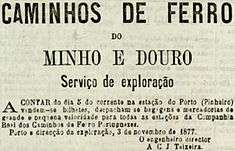
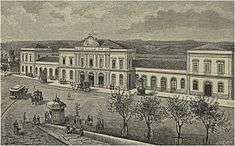
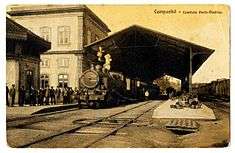
The first plan for a station was presented in 1860, to be built in Esteiro de Campanhã and that connected the Douro line to Minho, through an extension that follows the Campanhã valley to the branches along the Rio Tinto.[2] Initially designated, the Estação de caminho de ferro do Pinheiro (Pinheiro Railway Station), the station at Campanhã was designated for lands occupied by the estates of Quinta do Pinheiro and Quintas do Valado.[2]
In 1872, the current layout was definitively set by Manuel Afonso Espregueira, Pedro Inácio Lopes and Alexandre Eiffel.[2] Manuel Afonso de Espregueira, from Viana do Castelo, had a licentiate degree in mathematics from the University of Coimbra, and completed courses in infantry and general staff at the Escola do Exército (Military School).[2] Later he attended the École Imperiale des Ponts et Chaussées, in Paris, where he was one of the better students and colleague of other important people, such as Sadi Carnot (later President of the French Republic.[2] In 1880, he abandoned the army and entered the public service (specifically the Ministry of Public Works) where he held various positions and was part of several projects (such as artificial port of Leixões, improvements to the Barra do Porto and Figueira da Foz, among others). He was a director of the first Divisão Hidráulica do Reino (Hydraulic Division of the Kingdom) that was responsible for ports and inlets along the area north of the Mondego, except Aveiro.[2]
Between 1872 and 1885, Manuel Afonso de Espregueira, was director general for the Companhia Real dos Caminhos-de-ferro (Royal Railway Company), but in 1874, he was responsible for the elaboration of the general plan, that included all the lines that crossed the Douro and Norte region.[2]
By 1875, the first trains began to run along the northern Douro, between Pinheiro-Campanhã and Braga. On 28 April, they began work on the "Eiffel Bridge", projected by Seyrig from the Eiffel School of Paris.[2]
An accord was established between the government and the Royal on 15 September 1875, to begin the construction of the railway station.[2] On 4 November 1877, following diverse vicissitudes during the construction, the inauguration, along with that of the Bridge D. Maria Pia was celebrated, with the presence of King D. Luís and Queen D. Maria Pia.[2] The first train arrived the railway station from São Bento in 1896.[2]
In 1923, Cottinelli Telmo in partnership with Luís da Cunha, authored the first project plan to construct a dormitory for railway personnel, but was never executed.[2] A second version, which was submitted in 1925, was approved. Between 1943 and 1945, Cottinelli Telmo expanded the construction by building a warehouse for foodstuffs.[2]
By decree 104/97, the management of the railways was entrusted to a new company, the Rede Ferroviária Nacional (National Railway) in 1997.[2]
Commemorations celebrating the Portuguese railway system's 150 years were celebrated at Campanhã in 2006.[2]
Architecture
.jpg)
.jpg)
The station is situated in an isolated space, implanted on level terrain, on the western end of the city of Porto, along the right margin of the Douro River.[2] The principal facade is exposed to the Largo da Estação towards the urban centre of Campanhã, and its rear towards the railway lines and departure platforms. In actuality it is a central station to the city.[2]
The station includes, not only the passenger terminal, but also some support buildings, with sanitary installations, covered wharfs and carriage house. The main building has a rectangular plan, that comprises five bodies, that occupy a linear tract.[2] The rectangular, two-story, central corp is slightly extended from the main body, and flanked by the lateral, single-story wings, that extend to another two lateral sections.[2] The facades are plastered and painted in white, along with the frames and bunting, while the pilasters, decorative friezes and cornices are in granite.[2]
All first-story facades are broken by rounded windows or doorways, interspersed by pilasters and ionic capitals, while similar motifs are included in the upper floor of the central block.[2] This facade (oriented to the west) is divided into five sections, with the central partially section decorated in granite, with split silhouettes, while the floors are separated by friezes and cornices, this topped by elaborate friezes along the second floor, punctuated by three central inscriptions PORTO - CAMPANHÃ - PORTO and a minor inscription under the cornice: REFER.[2] The frontispiece integrates a circular clock, flanked by fins, and finished in semicircular pediment with wide phytomorphic key.[2] On the ground floor there are three perfect, molded back porticos, with flagstone integrated with two windows on each side.[2] On the upper floors there are six balcony windows, surrounded by rectangular frame and topped by cornice, protected by stone balusters (on the central section) and iron railings on the sides.[2] The intermediate sections are torn by six spans identical to those on the ground floor of the central facade.[2]
The facades of the lateral bodies, are broken by two windows and central door (at ground floor) and three balcony windows (on the upper floor). The lateral facades with identical layout, has a visible mezzanine between the two floors, while underneath the frieze is a blue-and-white azulejo panel, with the inscription PORTO CAMPANHÃ.[2]
The rear facade is symmetrically-broken by numerous spans of identical composition, with a full-length porch, resting on the cornice and iron pillars resting on granite plinths, supported by the boarding platform.[2]
Service
Campanhã station is one of two railway stations in Porto, with the other being the São Bento (the city centre terminus station for local trains and passenger service to the north, including the Douro line). All Comboios de Portugal (CP) services operate through Campanhã, including other services such as the Alfa Pendular high speed trains and Inter Cidades (inter-city) suburban trains, which continue on to São Bento. Suburban trains coming from General Torres reverse here and continue to São Bento.
| Preceding station | Comboios de Portugal | Following station | ||
|---|---|---|---|---|
| Vila Nova de Gaia toward Lisboa-Santa Apolónia |
Alfa Pendular | Famalicão toward Braga | ||
| Alfa Pendular | Trofa toward Guimarães | |||
| Lisboa-Oriente toward Faro |
Alfa Pendular | Terminus | ||
| Vila Nova de Gaia toward Lisboa-Santa Apolónia |
Intercidades | Famalicão toward Braga | ||
| Intercidades | Trofa toward Guimarães | |||
| Intercidades | Trofa toward Viana do Castelo | |||
| Intercidades | Trofa toward Guarda | |||
| Intercidades | Trofa toward Covilhã | |||
| Terminus | Celta | Nine toward Vigo-Guixar | ||
| Vila Nova de Gaia toward Lisboa-Santa Apolónia |
InterRegional | Terminus | ||
| Porto-São Bento Terminus |
InterRegional | Ermesinde toward Pocinho | ||
| Terminus | InterRegional | Ermesinde toward Valença | ||
| Vila Nova de Gaia toward Coimbra |
Regional | Terminus | ||
| Vila Nova de Gaia toward Lisboa-Santa Apolónia |
Regional | |||
| Porto-São Bento Terminus |
Regional | Ermesinde toward Régua | ||
| Terminus | Regional | Ermesinde toward Viana do Castelo | ||
| Preceding station | CP Porto | Following station | ||
| Porto-São Bento Terminus |
Linha do Marco | Contumil toward Marco de Canaveses | ||
| Linha de Guimarães | Contumil toward Guimarães | |||
| Linha de Braga | Contumil toward Braga | |||
| Linha de Aveiro | General Torres toward Aveiro |
Porto Metro station
Campanhã | |||||||||||||||||||||||||
|---|---|---|---|---|---|---|---|---|---|---|---|---|---|---|---|---|---|---|---|---|---|---|---|---|---|
| Porto Metro station | |||||||||||||||||||||||||
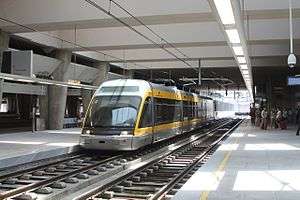 | |||||||||||||||||||||||||
| Location | Campanhã, Porto Portugal | ||||||||||||||||||||||||
| Line(s) | |||||||||||||||||||||||||
| Platforms | 2 side platforms | ||||||||||||||||||||||||
| Tracks | 2 | ||||||||||||||||||||||||
| Construction | |||||||||||||||||||||||||
| Structure type | At Grade | ||||||||||||||||||||||||
| Disabled access | Yes | ||||||||||||||||||||||||
| History | |||||||||||||||||||||||||
| Opened | 5 June 2004 | ||||||||||||||||||||||||
| Services | |||||||||||||||||||||||||
| |||||||||||||||||||||||||
Campanhã is an integral line within the Metro do Porto, except Line D; all these services route through the station. Campanhã is also the terminal hub of Line C, which connects the station to ISMAI (Instituto Universitário da Maia). Passenger trams stopping at Campanhã allow offload to other routes, but farther beyond the terminal station for visitors to the Estádio do Dragão and railyard.
References
Notes
- "In and around the station: Estação de Campanhã". CP. Retrieved 29 September 2011.
- Filipe, Ana (2009), SIPA (ed.), Estação Ferroviária de Campanhã (IPA.00023030/PT011312030368) (in Portuguese), Lisbon, Portugal: SIPA – Sistema de Informação para o Património Arquitectónico, retrieved 9 April 2017
Sources
- Martins, João Paulo (1995), Cottinelli Telmo. A Obra do Arquitecto (1897-1948). Dissertação de mestrado em História da Arte (in Portuguese), Lisbon, Portugal: FCSH/University of Lisbon
- Ramos, Luís A. de Oliveira (1994), História do Porto (in Portuguese), Porto, Portugal: Porto Editora